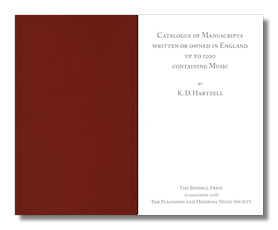
The Internet's Premier Classical Music Source
Related Links
-
Introduction
Acoustics
Ballet
Biographies
Chamber Music
Composers & Composition
Conducting
Criticism & Commentary
Discographies & CD Guides
Fiction
History
Humor
Illustrations & Photos
Instrumental
Lieder
Music Appreciation
Music Education
Music Industry
Music and the Mind
Opera
Orchestration
Reference Works
Scores
Thematic Indices
Theory & Analysis
Vocal Technique
Search Amazon
Recommended Links
Site News
 Book Review
Book Review
Catalogue of Manuscripts

Written or Owned in England
up to 1200 Containing Music
K. D. Hartzell
Woodbridge, Suffolk: Boydell. 2007. 741 pp
ISBN: 1-84383-281-X
ISBN-13: 978-184383-281-2
This is a hardback book of over 700 pages which will appeal mainly to early music enthusiasts. It details and describes some 364 manuscripts and similar musical sources from the ninth century down to 1200 CE. These are essentially the primary sources of the recorded musical tradition for the whole of England for that period. The sources are held or owned at or by 75 institutions or individuals. At first sight that might seem too specialist or arcane an area to be of real, wider, interest to music-lovers. It's certainly an expensive book at US$170 or £90.
But when you consider not only the value of the treasure in question, but also that it's here gathered for the first time in one place, and compiled and presented so expertly, Catalogue of Manuscripts Written or Owned in England up to 1200 Containing Music should prove of value, stimulus and be a significant resource not just for practicing performers and listeners but also for the wider medievalist community.
To say the text is both substantial and meticulously prepared is an understatement. Almost everything you would want to know about each of the manuscripts is there: the breadth is exhaustive; the depth encyclopedic. What's more – although there have been precedents (notably Frere's "Bibliotheca Musico-Liturgica", Georg Olms, Germany 1967 no ISBN) – Hartzell's book is by far the most complete and accessible volume dealing with this area. There is a tendency, perhaps, to think that what we have from these 500 years or so is amorphous, unknown – and, worse, unknowable. A mass of uncollected sources which find their way into collections and performances willy-nilly just for the initiated. Yet only when the totality of this immense treasury has been aggregated into one place and effectively tabulated as it has here can we really hope to make sense not only of the relative weights and merits of the corpus but also can we begin to understand its significance for musical, and indeed wider cultural, history. To have the measure, so to speak, of this immensely important period of musical development set out in such detail allows us indeed to survey developments such as in neumatic style and puncta. Such an expertly prepared text also allows us to understand each piece (or fragment) in context. To appreciate how our interpretation of recorded sources needs to be amended and revisited because traditions and practices of recording are so amply exposed in this study. Performers, musicologists, commentators – and thus listeners – are working with brighter light shone on the whole world from which any one piece comes.
To have the corpus of all English manuscripts laid out like this in one place is likely to lead to the availability of new and exciting music for musicians to discover and for us to listen to. For that alone we should be grateful to Dr. Hartzell, who is Professor of Music Emeritus, University at Albany, New York.
All cross-referenced entries are ordered alphabetically by holding location or institution; containing publication/manuscript (if any); date; at least one introductory paragraph; usually one or more articles of commentary with sources to bibliographical standards (indeed Hartzell's gloss on this format in the introduction occupies over two pages – an indication of the density of information in this book). Where information is missing or lost, it is usually indicated as such. There are paleographical and codicological analyses. These are complemented with a dozen-page bibliography, comprehensive indices of incipits and subjects… "blessing", mass types, "Dunstan", "St Rufus" etc. There are eight full-page (monochrome) plates. The format and rationale for the organization of the records is deftly described over almost ten pages in the introduction. It's in that part of the book that readers will learn that Dr. Hartzell spent nearly thirty years visiting libraries in Europe and the United States, examining 1,500 manuscripts; some more than five times. He saw every source in the book except one. Reading of these manuscripts by their (numerical, catalog) names has the effect of conferring on each the status almost of old and familiar friends – perhaps like oft-read letters from a loved one no longer alive. That's an indication of the accessibility of this remarkable volume, for all its scholarly rigor and depth.
No, this will not be every music lover's spare time reading. But its appeal as a repository detailing so expertly the very foundations of one of the greatest Western musical traditions is a strong one. Unlikely to be surpassed in the near future, as a reference source only marginally less 'basic' than the primary sources it collects themselves it's invaluable and deserves to be known about and consulted at least by anyone concerned really to understand not only how early music developed over those 500 years before the huge changes at the end of the twelfth century, but also just what a rich body of music is available to us from that period in its own right.
Copyright © 2008 by Mark Sealey


















